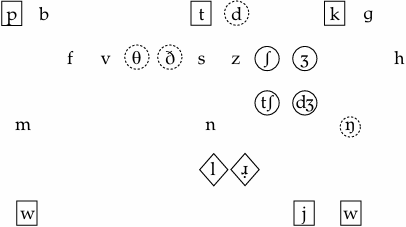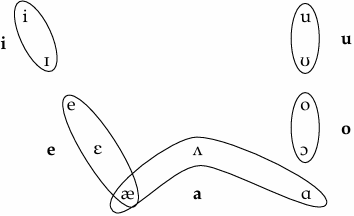


 Grammar
Grammar
 Tenses
Tenses
 Present
Present
 Past
Past
 Future
Future
 Parts Of Speech
Parts Of Speech
 Nouns
Nouns
 Verbs
Verbs
 Adverbs
Adverbs
 Adjectives
Adjectives
 Pronouns
Pronouns
 Pre Position
Pre Position
 Preposition by function
Preposition by function 
 Preposition by construction
Preposition by construction
 Conjunctions
Conjunctions
 Interjections
Interjections
 Grammar Rules
Grammar Rules
 Linguistics
Linguistics
 Semantics
Semantics
 Pragmatics
Pragmatics
 Reading Comprehension
Reading Comprehension|
Read More
Date: 24-3-2022
Date: 2024-06-13
Date: 2024-06-16
|
The overlay of the L1 consonants onto the English targets results in the following picture:

Other Greek phonemes not relevant for mismatches are /x, ɣ/.
Starting with the targets missing in the L1 inventory, we note the lack of palato-alveolar fricatives /ʃ/ and /Ʒ/; these tend to be replaced by the alveolar fricatives with their combinations with [j] as [sj] and [zj] respectively. Also lacking in Greek are the palato-alveolar affricates /tʃ/ and /dʒ/, which are replaced by the closest native alveolars, /ts/ and /dz/, respectively.
Although circled as a missing target phoneme, /ŋ/ is a little different from the others, because [ŋ] is an allophone of /n/ in Greek occurring before velar obstruents. Thus, problems are expected only in its occurrences in English with no adjacent velar stops.
Voiceless stops in Greek are always unaspirated. Thus, problems are expected for the English targets in the beginning of stressed syllables.
As far as the salient phonetic differences are concerned, we need to high light the liquids. The Greek alveolar lateral is always ‘clear’ and exemplifies a salient phonetic difference; the r-sound in Greek is also noticeably different, as it is an alveolar flap or trill. A minor difference can be cited between the /t/ and /d/ phonemes in the two languages; while these two are alveolars in English, they are dentals in Greek.
Positional/distributional restrictions are also sources of difficulty. All Greek consonants can occur initially and medially, and all except /d, θ, ð/ (among the relevant ones) occur finally. Thus, English targets with the above three in final position may cause problems.
Glides /w, j/ can create problems between the two languages, as Greek learners of English tend to hear and pronounce these glides as high vowels /u/ and /i/ respectively. While there is sufficient phonetic similarity between the glides and the corresponding high vowels, pronouncing them as vowels will give the impression to the English native speaker that there are separate syllables.
Vowel mismatches create the following insufficient separations for the target distinctions:

Greek has no diphthongs, but two vowel sounds can occur in sequence, and thus learners can handle the target English diphthongs.
Major problems with phonotactics are associated with the final clusters, which are non-existent in Greek. Thus, in addition to some simple codas pointed out earlier, Greek speakers will have problems with all the complex codas of English.
Greek is another syllable-timed language in our list, and expectedly has no vowel reduction. This results in considerable difficulties in learning the rhythm of English. In addition, different lexical stresses in the two languages are sources of problems.
The following summarizes the major trouble spots:
• missing target phonemes: /ʃ, Z, tʃ, dʒ/;
• aspiration;
• distributional restrictions: /θ, ð, d/;
• salient phonetic differences: approximants;
• insufficient separation of target vowels;
• stress;
• rhythm.
|
|
|
|
للعاملين في الليل.. حيلة صحية تجنبكم خطر هذا النوع من العمل
|
|
|
|
|
|
|
"ناسا" تحتفي برائد الفضاء السوفياتي يوري غاغارين
|
|
|
|
|
|
|
ملاكات العتبة العباسية المقدسة تُنهي أعمال غسل حرم مرقد أبي الفضل العباس (عليه السلام) وفرشه
|
|
|